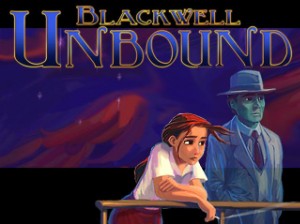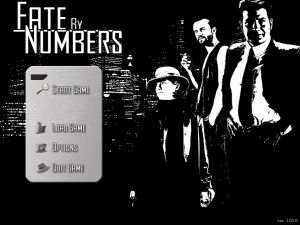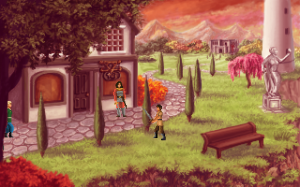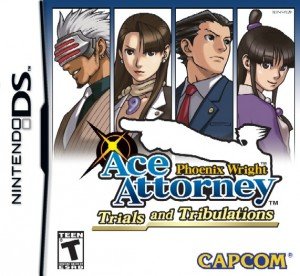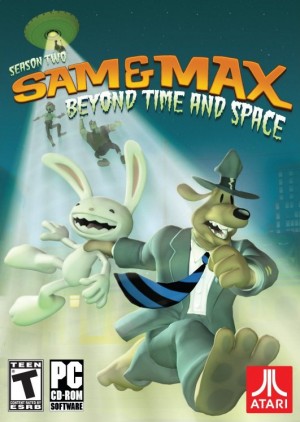Review for Trauma

Many games deal with the relatively basic emotions of anger, frustration, and joy. Few games deal with complex emotions like grief and loss, and even fewer attempt to do so with more than a minimum of subtlety or nuance. So kudos are in order to indie developer Krystian Majewski for tackling subject matter rarely seen in gaming, and attempting to do so in an experimental new way. Unfortunately, the end product of Trauma is experimental almost to the point of removing gameplay altogether. Ostensibly a first-person, node-based point-and-click puzzle adventure, in reality Trauma is more the adventure game equivalent of a tone poem—big on atmosphere and vague evocations of plot and emotion; not so much on specifics, substance, or even player participation. It’s not a bad game so much as it’s simply not much of a game at all.
In Trauma, you play as an unnamed young woman recovering in the hospital from a car accident that resulted in the death of her parents. During her recovery, she lapses into dreams that you as the player will explore. Why? To help her piece together what happened and come to terms with the loss of her parents… Or something. I dunno. What the premise comes down to is playing through a series of four tiny vignettes (which can be tackled in any order), each representing a different dream, and each with a different goal. One takes place on an empty road with the goal of “following the arrows.” Another takes place in a run-down industrial district with the objective of “catching the ghost.” Why you have to do this and what you achieve through success never really come into play—after all, you’re dreaming, so who cares?
The meat of the gameplay is the use of “gestures” of light that players must paint on the screen with the mouse cursor by holding down the left-mouse button. These gestures can turn your view or impact the environment, like cutting through or lifting an object. If there are “puzzles” in this game, they consist of determining where in the dreams to use your limited repertoire of gestures, but there are only a few predetermined spots where each gesture can be used, and it is almost always obvious. The gesture recognition system is easy to master, as there are only a few gestures and they’re rather simple to draw. The only real challenge whatsoever is finding some of the less obvious areas, as moving through the dreams is inconsistent and obtuse. Turn left in one area and you’ll actually turn left. Turn left in another and you’ll end up on a hill nearby looking in the opposite direction. While it would be foolish to expect the polish of a full development team from a single person, Trauma’s navigation is nevertheless more frustrating that it needs to be.
Completing a vignette—for example, by using a specific gesture on a conspicuous rock—rewards the player with a short fragment of conversation between the woman in the hospital and… someone, likely her doctor or physical therapist. These conversations are vague and unemotional, and don’t add up to much even after you’ve unlocked all four. Each episode also contains nine photographs scattered around, and three “alternate” endings. The alternate endings are as easy to complete as the “real” endings, the only difference being that there is no reward other than a check on the list of alternate endings in the main menu. The photographs contain either examples of gestures (some new, some repeated from the other dreams) that you can use from that point on or memories from the protagonist’s life, accompanied by a bit of narration. A few photographs contain “hints” that are quite explicit and obvious—a picture of a scene from another dream with the name of the gesture you should use there.
The narration is the vehicle for most of Trauma’s “plot” development. The woman’s voice, detached and with a thick (though understandable) German accent, breaks in on nearly every screen with a snippet of dream world musing, such as “I have forgotten who the ghost is, though I used to know,” or “Every few feet there is a clearing, but it never feels comfortable enough to rest. I always feel as if I am making a mistake.” Some are more concrete than others, but in general the narration is symbolic of the barely-lucid surrealistic logic of a dream. The voice acting works well enough, though by design the actress playing the main character has no emotion and a steady, flat cadence.
Majewski studied at a design school, and it shows—the game’s aesthetic is by far its strongest element. The dream worlds are comprised of altered photographs with one foot in the real world and the other in unreality. The slideshow nature of navigation actually makes sense considering the prevalence of the photography motif—each movement is accompanied by the click of a camera shutter, suggesting that even the woman’s dreams are viewed through a camera. There is also a consistent design between the menus and game that lends it a unique identity. The colors, lens flares, and the general emptiness of the dreams are surreal and effective, and despite being based on photographs of more or less everyday settings such as railyards and freeways, you wouldn’t mistake Trauma for another game.
Occasionally you’ll also come across a snippet of video, usually triggered by completing one of the dreams. The scenes vary from fantastical CG work depicting bizarre dream logic (blood cells floating through the air; a building being sucked into a drain in the sky) to live-action video of the young woman recovering in the hospital. Both the computer-generated clips and the live-action scenes are consistent with the still photography and anchor the game in the surreal and real, respectively. The music works well, even if it does little to distinguish itself: a few slow, evocative ambient tracks full of piano, strings, and down tempo beats fit an ethereal world like this.
So Trauma looks great and has some cool ideas, but in the end it feels unsatisfying. The initial intrigue generated by the unique concept fades as you realize that the entire game consists of using the same three or four gestures (not counting swiping gestures for navigation) in obvious places and hunting for Polaroids, all for meager rewards. What’s more, the game takes only about two hours to complete, including every alternate ending and hidden photo. Without those extras, the core game would take around twenty or thirty minutes. While the game is inexpensive, it still feels insubstantial, in large part because the story feels disconnected and vague rather than minimalist or profound. There is no real conclusion to speak of, no narrative arc, and only a little character development. Again, I’ll return to the tone poem comparison: certainly the game is evocative, and even emotional; there just isn’t much to it.
It should also be noted that Trauma is playable for free in its entirety on the official website. The free version is exactly the same with a few small differences: somewhat lower-resolution images and video, significantly longer load times (since you are streaming each vignette from the server), and occasional messages asking you to consider buying the game to support the developer. It is much, much easier for me to recommend the game as a free browser-based Flash game than as a commercial product. It’s certainly worth taking a look: it’s short enough for the mildly curious to experience the entire thing without spending much time, and the atmosphere and premise are compelling even if the gameplay doesn’t measure up to Majewski’s artistic ambitions. Who knows, perhaps some will decide to throw down the money for the downloadable version to support Majewski’s budding game development career. Hopefully we’ll see more from him in future, as Trauma shows a lot of promise, and you can consider me curious to see what he can do with a more substantial project next time around.








